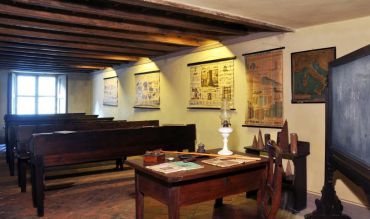Museum of the Botanical Garden, Turin

Museum of the Botanical Garden (Museo dell'Orto Botanico) in Turin is actually more like a landscape park. It belongs to Turin University and is located on the territory of the old Valentino Castle. The garden has an impressive collection of plants. Here, both children and adults will fully enjoy the diversity of the flora.
History of the Garden
In 1566, the first private collections of plants were transferred to Turin University. In 1713 the Royal Garden was established on the territory of the castle on the bank of the Po River. A little later, in 1729, the University of Turin organized the Department of Botany, and the garden became a part of it. This year is considered the official date of its foundation. During the following century, the garden collections became richer, new greenhouses appeared. It reached its peak in 1892. In the days of fascism and the World War II, the garden decreased in size and was significantly destroyed. However, after almost 20 years it was restored. By 1963 an alpine garden and new greenhouses for plants of different climatic zones appeared here. In 1997, the institution opened its doors to the public, ceasing to be only a scientific project
Collections of the Garden
Today the Botanical Garden has a number of developed routes, one of which is for blind people. Programs for visitors of absolutely different ages are developed here: from preschoolers to adults. And each group will be informed in their own way. Thus, the garden began to conduct more and educational activities, besides the research. At its disposal it has 2.6 hectares of land and more than 2,000 plant species, which are divided into 6 different zones in accordance with climatic requirements.
- Grove. Wooded area, created on the hills of the banks of the Po River with a decorative purpose. It was created in 1830, when about 100 trees were planted in the northern part. Some of them have survived to this day. Among them – oak, forest beech, yew berry, ginkgo biloba and Lebanese cedar.
- Garden. The history of the institution began from it. It includes a central alley with old trees, neat flower beds and 3 water pools. It contains examples of typical flora of the Apennines: flowers, fruit trees, medicinal and aquatic plants.
- Alpine garden. It recreates the natural environment of growth of alpine flora species. Many of the plants presented here grow at an altitude of 1500–2000 meters. Some samples were taken from nature, others were borrowed from botanical gardens.
- Tropical greenhouse. It was rebuilt in 1999. Here, among other tropical plants, many orchids cultivated in the garden since the 19th century are grown.
- Greenhouse with succulents. It was established in 1985 and reconstructed in 2000. About 350 species of plants grow here, which are adapted to the arid environment. Prevailingly, those are cacti from different continents.
- Greenhouse of Southern Africa. It is the youngest one and it was built in 2007. Here, the spieces that grow in the corresponding part of the continent are recreated. It has about 500 plant species.
Another interesting feature of the botanical garden is the possibility of visiting an apiary created in 2010.
How to get there
The Museum of the Botanical Garden is located in Parco del Valentino, near the city center, on Viale Mattioli, 25. The park has a number of monuments, beautiful fountains and it is a good place to relax. And near the park there are the Fruit Museum and the Museum of Anatomy. The most convenient way to get to the garden is by trams № 7, 9, 16CD, 16CS, and buses № 24, 33, 52, 93/. Get off at the Massimo d'Azeglio stop.
Opening hours: The garden is open to all visitors during the warm season, from April 14 to October 28. From Monday to Friday from 9:00 to 12:00, on Saturday from 15:00 to 19:00, on Sunday from 10:00 to 19:00. Visits to the apiary are possible every second Sunday of the month. Phone number (+39) 011 6705970.
Admission: the cost of a full ticket is 5 euros, with a discount (pensioners, children 6-12) – 3 euros. For groups of 10 to 25 people, the total price of a group ticket is 50 euros. For children under 6 – admission is free. Data of April 2018.






